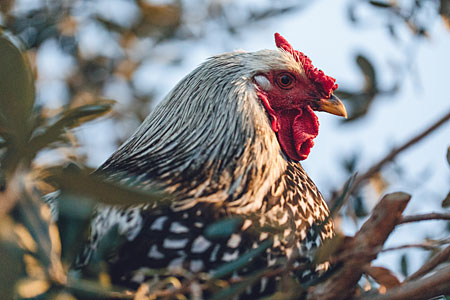
Chickens, including bantams, tend to do better in cold weather than in hot weather. However, some bantams tolerate the cold better than others. Certain features — such as dense plumage, leg feathering, beards, and small combs — contribute to a cold hardiness. Often the country of origin provides a clue to a breed’s climate tolerance. Below are 11 cold hardy bantam breeds.
Dense Plumage
One feature of cold hardy bantam breeds is dense or tight plumage. A thick or tight coat of feathers helps these bantams resist the cold. However, some of the following breeds also have large single combs and wattles that make them more susceptible to frostbite. Visit our blog How to Protect Your Chickens from Frostbite.
Brahma bantam — The Brahma bantam, from Asia, not only has dense feathers but also has the cold-climate advantage of leg feathers and a pea comb
Cochin bantam — Also from Asia, the Cochin bantam has dense plumage and feather legs. However, it has a large single comb and wattles.
Orpington bantam — The Orpington bantam originates from England. Although it has dense plumage, it too sports a large single comb and wattles.
Plymouth Rock — Originating in Massachusetts, the barred Plymouth Rock and Columbian Plymouth Rock bantams have large combs and wattles. But their tight feathering gives them a cold weather advantage.
Rhode Island Red bantam — Originating in Rhode Island (of course), the Rhode Island Red bantam features tight feathering, but large comb and wattles.
Wyandotte bantam — From England, the Wyandotte bantam has dense plumage plus a rose comb.
Beard and Muffs
Feathers on normally exposed body parts, such as the legs and feet, or surrounding the beak (beard and muffs), enhance a bantam’s cold hardiness. Brahmas and Cochins (as mentioned above), have leg feathers. All the following breeds have a beard and muffs.
d’Anvers – The d’Anvers bantam from England has, in addition to beard and muffs, a rose comb and wattles that are small or nonexistent.
d’Uccle – The d’Uccle bantam from Belgium, sports not only a beard and muffs, but also leg feathers. Although this breed has a rather large single comb, the wattles are small.
Easter Egger bantam – From the United States, bearded and muffed Easter Egger bantams usually have a pea comb, although some have a single comb.
Rose Combs
Many cold hardy breeds feature small pea combs or rose combs and small wattles. These features reduce heat loss and are less likely to freeze. As previously mentioned, Brahmas and most Easter Eggers have a pea comb. d’Anvers and Wyandottes, mentioned above, have a rose comb, as do the following breeds:
Dominique bantam – The Dominique bantam from Canada was developed specifically as a cold-climate breed.
Rosecomb – The Rosecomb, from England, matures slowly, requiring extra care until it reaches maturity. But as an adult it is extremely robust and hardy.
Cold Weather Care
The following blogs describe cold weather care that is suitable for all breeds, even those that are exceptionally cold hardy.
What Kind of Care Do Chickens Need in Winter?
Prepare Your Chicken Coop for Winter
And that’s today’s news from the Cackle Coop.
Gail Damerow has authored numerous books about poultry, including The Chicken Encyclopedia.

